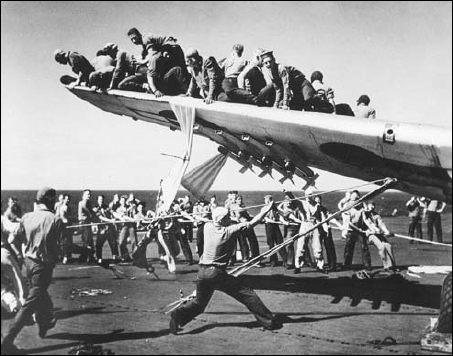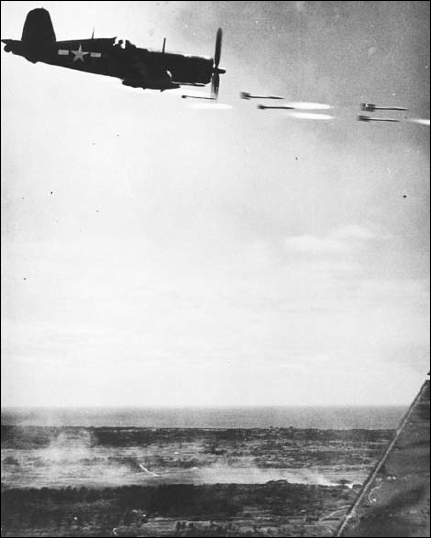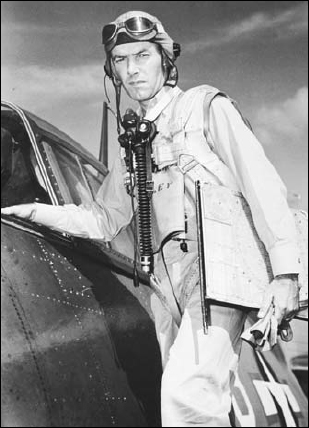
At the start of the war the United States Navy had two excellent machine guns, the .30 caliber M1919MA4 (AN-M2) and the .50 caliber M1921M2. Both were manufactured in the United States in versions designed for both land and air combat and were carried on virtually all US Navy aircraft. In 1941 the typical USN fighter plane was armed with four .50 caliber Browning M2 heavy machine guns. These highly successful weapons had already proved their worth in action all over the world. But if the weapons were adequate for the job ahead, the aircraft were not. The Navy’s F2A Buffalo fighters had been of sound design before the war, but by 1941 they were hopelessly obsolete. Other fighterplane designs were already planned, but it would take time for them to be produced in numbers.

The US Navy continued to experiment with air-launched rockets throughout the war. Shown here mounted on the wing rails of a TBM “Avenger” are the 3.5 in. ARs. In this photograph Navy deck crew attempt to keep the TBM from going over the side of the ship. (National Archives)
In contrast to the Buffalo, the Grumman F4F Wildcat was a promising design. Although armed only with four .50 caliber guns and without folding wings as yet, the Wildcat was still a sturdy, heavily armored and reliable fighter. But it too had flaws in its design: the loading of the ammunition for the machine guns was far from perfect, causing jamming in battle. Pre-war testing of the gun systems by the Navy VF squadrons was always performed at far less than the aircraft’s full capacity for ammunition and under less than realistic combat maneuvering conditions. In combat, high G maneuvers would cause the ammo belts on the early production F4Fs to kink, resulting in a jam. This was a serious problem for the wing-mounted M1921M2 in combat throughout the first year of the war.
The M2 Browning was not the only machine gun utilized by the US Navy on carrier-based attack aircraft; both dive and torpedo bombers were armed with twin .30 caliber Browning M1919 machine guns. Mounted in the rear fuselage, these guns comprised the sole defensive armament for these slow-flying aircraft. By and large in the first year and a half of the war they proved little more than a nuisance to attacking Japanese aircraft, entirely useless for any but direct stern attacks. By the end of the war, however, the armament of these aircraft had been increased to two .50 caliber M2 machine guns, which gave the SBDs and TBFs a good chance to defend themselves against enemy attack.
As the war progressed, it was found that fighters could be more effective in close support of ground troops if they were armed with rockets, in conjunction with their normal array of heavy machine guns and wing cannons. Originally designed by the British for use against German U-boats, these first air-to-surface weapons were 3.5 in. in diameter and carried a solid warhead.

By the war’s end the US Navy had developed a 5in. high velocity HVAR rocket known as “Holy Moses” to aid the Marines in the role of close air support. This weapon was also used in an anti-shipping role against Japanese naval targets. (National Archives)
Aviation ordnance man Paul Hoff was one of the first Americans trained in the use of the new weapons aboard the USS Block Island (CVE 21) in the Atlantic:
Being the youngest second class in the ordnance gang I was given the job of handling the 3.5s. I think that all the older guys would rather load bombs and machine guns, they (other ordnance men) didn’t like them because they were new weapons.
Yet in spite of the new and untried status of these weapons, the 3.5 AR (air rocket) proved to be a safe and effective weapon in the war against the U-boat. Unlike conventional depth charges, the 3.5 in. rockets gave the pilots of the TBF/Ms a piece of ordnance with the ability to strike U-boats directly.
The next generation of ARs saw the standard 3.5 in. rocket motor married to a 5 in. dual-purpose naval shell. The result was a weapon that was more effective against surface targets than the earlier 3.5 in. rocket, but with far less velocity and range. This lack of range and velocity was solved when the US Navy introduced one of the most successful of all air-to-surface rockets, the High Velocity Air Rocket, HVAR-5.

Taboo in the modern US Navy, this ordnance crew load their “love” message, a 1,000 lb bomb, into the bomb bay of a TBM. (National Archives)
These 5 in. rockets could be launched from a variety of aircraft including the F6F Hellcat, the F4U Corsair, and the TBF/M Avenger. One problem, however, was the use of a rail-launch system for the 3.5 in. AR. These rocket rails caused excessive drag on the aircraft in flight, effectively limiting the employment of rockets to the TBF/Ms. With the development of the HVAR-5 rocket a new limited drag, zero friction hard point was introduced. The practical results of the change would not only increase the velocity of the rockets but also allow them to be mounted on the sleeker, higher performance Navy fighters.
During the campaign to take the island of Okinawa, USN and USMC rocket-armed fighter bombers launched accurate air strikes against Japanese positions within 100 yards of the American front lines, greatly increasing the effectiveness of the ground attacks.
The HVAR, however, was not particularly useful against heavily armored fighting vessels. In response, the US Navy developed a large 11.75 in. attack rocket called the “Tiny Tim.” This huge weapon proved to be a failure because it could not be launched from hard points due to its large size. Moreover it had to free-fall before its engine would ignite, making the rocket very inaccurate.
An unfortunate incident in the history of the 11.75 in. rocket occurred in 1945 aboard the USS Franklin off the coast of Okinawa during a Japanese air attack. A member of the crew, Lt. Cdr. Samuel R. Sherman, MD, was on hand to report the effects:
I saw the Japanese plane coming in, but there was nothing I could do but stay there and take it. The plane just flew right in and dropped two bombs on our flight deck. I was blown about 15 feet into the air and tossed against the steel bulkhead of the island. I got up groggily and saw an enormous fire. All those planes that were lined up to take off were fully armed and fueled. The dive-bombers were equipped with this new “Tiny Tim” heavy rocket and they immediately began to explode. Some of the rockets’ motors ignited and took off across the flight deck on their own. A lot of us were just ducking those things. It was pandemonium and chaos for hours and hours.7
The United States Navy had played a leading role in the development of air-launched ordnance such as torpedoes and depth charges in the years leading up to World War I. During the interwar decades, in a climate of pacifism and arms limitations, the Navy lagged behind the other maritime nations of the world in the development of new antishipping ordnance. Most of the shortcomings of ordnance in the early years of the war were a direct result of poor design.
Furthermore, prior to the beginning of World War II, interservice rivalries had led to the development of two different and incompatible sets of bombs, one for the Navy and one for the Army. In the late 1930s this situation was remedied by the introduction of a joint service standard bomb, which, with certain variations, could be used by both Army and Navy aircraft. The primary difference between the two was the fuses: the Army variant was often armed as soon as it was released from the bomb rack, while the Navy version had a timed delay mechanism as a safety precaution for carrier operations.

A fine study of a fighter pilot prior to his flight in his F6F “Hellcat”. Of note is the metal plotting board and navigational compass. (National Archives)
In addition to the A/N bomb the Navy also maintained a number of special types of armor-piercing bombs in the 1,000 lb range that were specifically designed with delayed action fuses allowing them to penetrate a target’s armor prior to exploding. It was with these weapons that the SBD-2 and -3 “Dauntless” dive-bombers of VB-6 scored the two hits that sank the Japanese carrier Akagi at the battle of Midway.
One area of severe deficiency in the early war period was in the torpedoes with which the Fleet was armed. The Bliss-Leavitt Mk. 13, 14, and 15 torpedoes had several difficulties that needed to be overcome. Discussion will be limited to the Mk. 13, since the Mk. 14 and 15 were not air-launched weapons.

The carrier battles of 1942 had shown that the command of a task force was a demanding job on the admiral in charge of the Fleet. By 1944 the Americans had developed a system of command rotation whereby Admirals Mitscher and Halsey alternated command of the American Fleet. Here Mitscher and his chief of staff, A. A. “Thirty Knot” Burke, plan some of the operations off Okinawa in June of 1945. (National Archives)
The Mk. 13 was a product of the postwar experimentation that the Navy conducted during the 1920s. The Mk. 13 was a flawed weapon system for a variety of reasons. Since it was too heavy (2,216 lb/1,005 kg) to be carried by the biplane bombers of the early 1930s, the Mk. 13 never received realistic combat testing. It was also a relatively short weapon (13 ft 5 in.), making it unstable compared to the highly effective Japanese Type 94 “Long Lance” Torpedo. The Mk. 13’s design demanded that the approach run to the target be made at a speed of less than 90 knots and at an altitude of less than 100 feet. Even under ideal conditions the Mk. 13 was notorious for diving deep upon launch (sounding) or breaking up on contact with the water. If this catalog of woes were not enough, the Mk. 13 was a slow weapon, able to reach speeds of only 33 knots, requiring extreme skill or luck to score hits on swift Japanese ships.
Eventually most of the problems with the Mk. 13 were corrected by the simple expedient of attaching a wooden drag device to the weapon’s nose and a set of boxes to the tailfin to increase the stability and slow the speed of the torpedo as it entered the water. The wooden attachments would then break off and the weapon could run as normal.
Real torpedo improvement came with the introduction of the Mk. 24 acoustic homing torpedo, nicknamed “FIDO” because it would track a target like a bloodhound. Designed to counter the Axis submarine threat, the Mk. 24 was a miracle of wartime design necessity, having made the transition from initial design to Fleet introduction in a little less than 18 months. The Navy’s specification called for a weapon that could fit the standard aircraft 1,000 lb bomb rack and could be dropped from a height of 200 feet at a speed of up to 120 knots.
FIDO was equipped with hydrophones, which steered it toward the target by homing in on the source of the strongest sound signals in its vicinity. FIDO was also equipped with a device that was designed to protect friendly vessels, by turning off the acoustic homing device if the Mk. 24 rose too close to the surface. Even so, FIDO had difficulty in distinguishing between the sounds of Allied surface ships and of Axis submarines. As a consequence, the Mk. 24 was rarely used in conjunction with friendly surface vessels in ASW operations.